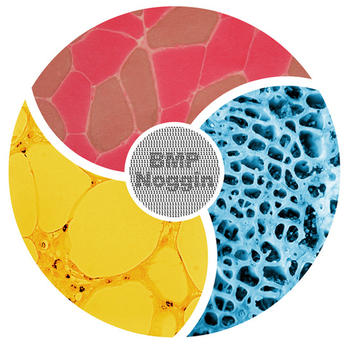Role of BMPs and their antagonists in controlling osteogenesis, myogenesis and adipogenesis
Coordinated tissue development and regeneration through balanced signaling cues is crucial for healthy tissue homeostasis.
BMPs are a major class of secreted metabologens that constitute pivotal morphogenetic signals and orchestrate general tissue homeostasis.
BMP signaling is fine-tuned at each stage of signal transduction, predominantly the BMP receptors. The extracellular BMP antagonist Noggin directly couples immediate and long-term environmental changes with the local and systemic operating mode of the cytokine. Thereby, BMP and Noggin form a mutually non-functional unit that abrogates extracellular BMP receptor binding, hence intracellular signal transduction.
Current knowledge suggests that deregulated local intra-tissue expression of BMP and Noggin impairs proliferative, apoptotic and differentiation processes with pathophysiological characteristics in bone, muscle and adipose tissue development. Interestingly, elevated circulating inter-tissue BMP and Noggin levels in adult mice and humans suggest that both factors play a putative role in energy balance and body weight regulation with consecutive implications on muscle and bone tissue homeostasis.
Therefore, it is suggested that besides BMP signaling, Noggin is a crucial factor in healthy bone, muscle and adipose tissue homeostasis. To understand the causal interrelation of how disintegrated local BMP signal adaptation affects systemic adjustments in the body we characterize diseases such as obesity and muscular atrophy through rare hereditary and frequent acquired pathophysiological mouse and human samples.
We use experimental and mathematical models which integrate cellular, tissue and systemic approaches to address whether imbalanced intra- and inter-tissue (ant)-agonist expression and functionality is the cause or the consequence of these conditions.
We aim to contribute to the molecular understanding of the pathomechanisms of obesity and muscular atrophy to provide potential new therapeutic approaches for the early detection of disease onset and progression and the causative treatment of consecutive diseases such as type 2 diabetes and osteoporosis.



